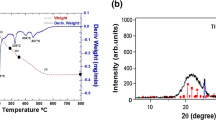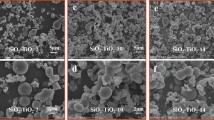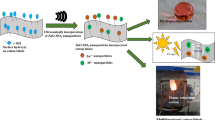Abstract
Silica and core–shell structured titania/silica (TiO2/SiO2) nanoparticles with particles size ranging from tens to hundreds of nanometers were prepared and deposited onto cotton fabric substrates by sol–gel process. The morphologies of the nanoparticles were characterized by field-emission scanning electron microscope (FE-SEM). The photocatalytic decomposition properties as well as UV-blocking properties of the fabrics treated with SiO2 and TiO2/SiO2 nanoparticles were investigated.
Similar content being viewed by others

Explore related subjects
Discover the latest articles, news and stories from top researchers in related subjects.Avoid common mistakes on your manuscript.
1 Introduction
It has been known that excessive exposure to UV radiation, which includes UVA (315–400 nm) and UVB (280–315 nm), can result in skin damage such as sunburn, premature skin aging, allergies, and even skin cancer [1, 2]. However, the protection offered by usual textiles is often inadequate [3]. Nanomaterials have recently attracted a great deal of interest as an effective way to develop new functional textiles and clothing. For instance, TiO2 nanoparticles have been coated on cotton fabrics as a UV-blocking layer [4–7]. The TiO2 layer had good adhesion to the cotton substrate and provided excellent UV protection to the skin.
Titania is widely used because of its superior photocatalytic properties and nontoxicity [8–13]. TiO2 nanoparticles show high photocatalytic activities because they have a large surface area per unit mass to volume ratio and a small particle size that facilitates the diffusion of photo excited electrons and holes towards the surface before their recombination [14]. It is well known that textiles are usually made of natural fibres such as cotton and silk or synthetic organic fibre. While titania particles on fabrics can show good UV-blocking properties, the strong photocatalytic activity of titania can also result in deterioration of the organic fibre. To address this problem, Qi et al. [15] suggested that the nanoparticles could be encapsulated by polymer such as polystyrene (PS). However, this polymer layer may also be deteriorated by the photocatalyst. In this letter, we propose a new route to prevent the contact between textiles and photocatalyst, that is, to use silica (SiO2) as an encapsulation shell to hybrid or coat on TiO2. We will demonstrate that SiO2 and TiO2/SiO2 has no photodecomposition effect on cotton fabrics. Since the coated silica layer is transparent, the UV-blocking property of TiO2/SiO2 nanohybrid coating was comparable to pure TiO2.
2 Experimental section
2.1 Preparation of nanoparticles
The synthesis process involved silica sol, TiO2/SiO2 sol grown directly on flexible cotton fabrics or padded on these substrates. The silica and TiO2/SiO2 sols were prepared by Stober method, typical procedure was as follows: 4 mL TEOS and 20 mL solution was added into the ethanol/ammonia/deionized water (90/5/5) solution under vigorous stirring. After 3 h, the silica sol was obtained. 1.0 g TiO2 spheres were dispersed into 50 mL ethanol. Then, 2.0 mL deionized water, 1 mL ammonia solution and 3 mL TEOS solution were added under vigorous stirring at room temperature for 3 h. The fabrics coated by silica and TiO2/SiO2 sols were directly used for further analysis.
2.2 Fabrics measurements
The morphologies of fabrics were characterized by FESEM (Leica Stereoscan 440, operating at 20 kV, and JOEL JSM-6335F at 3.0 kV). The dye solution used to test the photodecomposition is Neolan Blue 2G, 0.02%. 5 g fabric and 100 ml dye solution were brought together into a beaker. The absorbance of the solution was measured by UV–Vis spectrometer (Lamda 18). The photodecomposition was conducted in a home made cabinet with 3 UV lamps (Philips TC/C 40 W/05) as the light source hanging about 23 cm above an IKA Orbital Shakers (KS 260 basic) where is the solution was held. The detailed procedures were described as follows. First, all the four samples are exposed to UV light in the first 3 h in order to reach the equilibrium absorption of the dye. Those four samples are cotton treated with silica particles exposed to UV light, cotton treated with silica particles without being exposed to UV light, cotton treated with TiO2/SiO2 nanomaterials exposed to UV light and cotton treated with TiO2/SiO2 nanomaterials without being exposed to UV light, respectively. All of them are gently shaken during the whole process. (UV intensity is about 0.360–0.380 mW/cm2). Second, two beakers containing different treated samples were covered by a black fabric to resist the UV light. The other two were exposed to UV light all the time. Third, extract small amount of dye solutions in the 4 flasks were extracted and the absorbance was measured within the visible range (λ = 400–800 nm) after the extracted solution was centrifuged (2,500 rpm with 5 min). The UV-blocking properties of pure cotton fabrics and cotton fabrics treated with silica particles or TiO2/SiO2 composites were tested by a Varian Cary 300 UV spectrophotometer. Additionally, the above cotton fabrics are all performed washing experiments in order to test the stability of the coating.
3 Result and discussion
High magnification FE-SEM images of treated and untreated cotton fabric were shown in Fig. 1. It can be observed that the silica particles were uniform with a diameter of about 90 nm. However, TiO2/SiO2 nanoparticles were not uniform with a diameter ranged within 80–150 nm. TiO2 has been demonstrated to have adhesion to the cotton fabrics, resulting in excellent wash fastness [4]. Actually, TiO2/SiO2 composite particles also had good adhesion to the cotton fabrics and will be shown below. Figure 2 displays the photodecomposition of dye by SiO2 and TiO2/SiO2 nanoparticles grown on cotton fabric. The results showed that both samples do not have photodecomposition effect since the concentrations of the dye solution were nearly constant during the experiment. This implies that the TiO2/SiO2 particles had a core–shell structure where a silica layer covers completely an inner core of titania. In our previous work [7], the same dye (Neolan Blue 2G) could be decomposed completely within 3 h when bare TiO2 nanoparticles were coated on cotton fabrics.
The “ultraviolet protection factor” (UPF) defined in Australian/New Zealand standard AS/NZS4399: 1996 has now been adopted by the textile and clothing industry worldwide. UPF is the ratio of the average effective ultraviolet irradiance on unprotected skin to that on protected skin. A UPF value of more than 50 means excellent protection from the UV irradiance. The calculating formula is as follow,
where E λ = relative erythemal spectral effectiveness, S λ = solar spectral irradiance in W m−2 nm−1, T λ = spectral transmittance of the item, Δλ = wavelength step in nm, λ = wavelength in nm.
The UV absorption study of the fabrics treated with TiO2/SiO2 (Fig. 3c) revealed a higher UV protection factor (UPF) rating of +50 compared to untreated fabrics (Fig. 3a) and fabrics treated with silica particles (Fig. 3b). It can be calculated from Fig. 3 that the UPF of untreated fabrics, fabrics treated with silica and TiO2/SiO2 nanoparticles are 6.7, 23.1 and 170.1 respectively. Given the corresponding relation between the UV-blocking and the treatment, untreated fabrics had shown nonrateable, while fabrics treated with silica and TiO2/SiO2 nanoparticles had shown good protection and excellent protection respectively. The UV-blocking mechanism of this technology is attributed to the microstructure of the treatment: TiO2 and SiO2 coating can absorb light with an energy that matches or exceeds their band gap energy [16]. The high UPF resulted in an excellent protection classification compared to a low UPF rating which is classified as nonrateable for untreated fabrics. It should be emphasized that the UPF of the fabric treated with TiO2/SiO2 maintains good values above 50 after more than 30 times home launderings.
4 Conclusion
In summary, silica and TiO2/SiO2 nanoparticles were synthesized by sol–gel processes, and padded on cotton fabrics. The sizes of these particles ranged from tens to hundreds of nanometers. Fabric treated with TiO2/SiO2 nanoparticles showed better UV protection than the one treated with silica particles or untreated fabrics. Moreover, the coated nanoparticles showed no photodecomposition effect on the organic substrate materials. The experimental results and technical approach demonstrated the potential of TiO2/SiO2 core–shell structure in UV-blocking applications in textiles and toiletries while avoiding the photodecomposition effects on the organic substrate materials.
References
Hoffmann K, Kaspar K, Gambichler T, Altmeyer P (2000) J Am Acad Dermatol 43:1009
Hatch KL (2002) Recent Res Cancer Res 160:42
Palacin F (1997) Melliand Int 3:169
Xin JH, Daoud WA, Kong YY (2004) Tex Res J 74:97
Daoud WA, Xin JH, Zhang YH (2005) J Non-Cryst Solids 351:1486
Daoud WA, Xin JH, Zhang YH (2005) Surf Sci 599:69
Fei B, Deng Z, Xin JH, Zhang YH, Pang G (2006) Nanotechnology 17:1927
Fujishima A, Honda K (1972) Nature 238:5358
Wauthoz P, Ruwet M, Machej T, Grange P (1991) Appl Catal 69:149
Kato K, Tsuzuki A, Taoda H, Torii Y, Kato T, Butsugan Y (1994) J Mater Sci 29:5911
Christensen PA, Curtis TP, Egerton TA, Kosa SAM, Tinlin JR (2003) Appl Catal B 41:371
Daoud WA, Xin JH (2004) J Sol–Gel Sci Technol 29:25
Daoud WA, Xin JH (2005) Chem Commun 2110
Anpo M, Shima T, Kodma S, Kubokawa Y (1987) J Phys Chem 91:4305
Qi KH, Daoud WA, Xin JH, Mark CL, Tang W, Cheung WP (2006) J Mater Chem 16:4567
Zhang Y, Xiong G, Yao N, Yang W, Fu X (2001) Catalysis Today 68:89
Acknowledgments
This research was supported by the special co-construction project of Beijing city education committee, The Key Project of Chinese Ministry of Education (No: 107023), The Hong Kong Polytechnic University Postdoctoral Fellowship Scheme (G-YX70) and a grant from the Research Grants Council of the Hong Kong Special Administrative Region, China (No: PolyU5166/05E), Doctoral Program Foundation of Institution of higher education of China (2-2-08-07).
Author information
Authors and Affiliations
Corresponding author
Rights and permissions
About this article
Cite this article
Zhang, Y., Yu, L., Ke, S. et al. TiO2/SiO2 hybrid nanomaterials: synthesis and variable UV-blocking properties. J Sol-Gel Sci Technol 58, 326–329 (2011). https://doi.org/10.1007/s10971-010-2395-2
Received:
Accepted:
Published:
Issue Date:
DOI: https://doi.org/10.1007/s10971-010-2395-2






